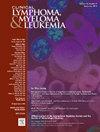酪氨酸激酶抑制剂治疗慢性粒细胞白血病的模式:来自中国的单中心数据。
IF 2.7
4区 医学
Q2 HEMATOLOGY
引用次数: 0
摘要
目的:描述中国某中心慢性髓性白血病(CML)患者酪氨酸激酶抑制剂(TKI)的治疗模式并分析TKI转换的协变量。方法:回顾性分析CP-CML患者TKI转换模式、原因及相关协变量。结果:回顾性调查了1766例最初接受伊马替尼(n = 1374)、尼洛替尼(n = 254)、达沙替尼(n = 63)和氟马替尼(n = 75)治疗的患者。中位随访时间为48 (IQR, 24-77)个月。一线TKI切换比例为32%(570/1766),二线为36%(208/570),三线为34%(71/208)。常见的治疗顺序包括伊马替尼-达沙替尼(37%)或尼洛替尼(35%),伊马替尼-尼洛替尼-达沙替尼(25%)联合2个开关,伊马替尼-尼洛替尼-达沙替尼-olverembatinib(18%)联合3个开关。TKI切换主要是由于抗性(跨系64%、76%、88%)和不耐性(19%、14%、7%)。多变量分析显示,ELTS中/高危组(相对于低危组)、男性和低血红蛋白与TKI切换的高概率显著相关。与伊马替尼相比,最初的尼罗替尼或达沙替尼的转换率较低。男性和ELTS高风险(相对于低/中等)与耐药性相关切换相关,而较低的血红蛋白、年龄较大和初始达沙替尼或氟马替尼(相对于伊马替尼)与不耐受相关切换到二线治疗相关。二线伊马替尼/氟马替尼(vs.尼洛替尼/达沙替尼)和无/非特异性ABL突变与转向三线治疗的耐药性相关。结论:这些发现强调了CP-CML患者管理的复杂性,并强调了个性化治疗策略的重要性。本文章由计算机程序翻译,如有差异,请以英文原文为准。
Tyrosine Kinase Inhibitor Treatment Patterns in Patients With Chronic-Phase Chronic Myeloid Leukemia: A Single Center Data From China
Aim
To describe tyrosine kinase inhibitor (TKI) treatment patterns and analyze co-variates of TKI switch for chronic myeloid leukemia (CML) patients in a center from China.
Methods
A retrospectively study was designed to analyze TKI switching patterns, reasons and associated covariates in patients with CP-CML.
Results
1766 patients receiving initial imatinib (n = 1374), nilotinib (n = 254), dasatinib (n = 63) and flumatinib (n = 75) therapy were retrospectively interrogated. Median follow-up was 48 (IQR, 24-77) months. TKI switch proportions were 32% (570/1766) for first-line, 36% (208/570) for second-line and 34% (71/208) for third-line. Common therapy sequences included imatinib-dasatinib (37%) or nilotinib (35%) in those with 1 switch, imatinib-nilotinib-dasatinib (25%) with 2 switches and imatinib-nilotinib-dasatinib-olverembatinib (18%) with 3 switches. TKI switches were mainly due to resistance (64%, 76%, 88% across lines) and intolerance (19%, 14%, 7%). Multivariable analyses revealed ELTS intermediate/high-risk group (vs. low-risk), male, and lower hemoglobin were significantly associated with a higher probability of TKI switch. Compared to imatinib, initial nilotinib or dasatinib had lower switch rates. Male and ELTS high-risk (vs. low/intermediate) were associated with resistance-related switches, while lower hemoglobin, older age and initial dasatinib or flumatinib (vs. imatinib) were associated with intolerance-related switches to second-line therapy. Second-line imatinib/flumatinib (vs. nilotinib/dasatinib) and no/nonspecific ABL mutation were associated with resistance-related switches to third-line therapy.
Conclusion
These findings emphasized the complexities involved in the management of patients with CP-CML and highlighted the importance of personalized treatment strategies.
求助全文
通过发布文献求助,成功后即可免费获取论文全文。
去求助
来源期刊

Clinical Lymphoma, Myeloma & Leukemia
ONCOLOGY-HEMATOLOGY
CiteScore
2.70
自引率
3.70%
发文量
1606
审稿时长
26 days
期刊介绍:
Clinical Lymphoma, Myeloma & Leukemia is a peer-reviewed monthly journal that publishes original articles describing various aspects of clinical and translational research of lymphoma, myeloma and leukemia. Clinical Lymphoma, Myeloma & Leukemia is devoted to articles on detection, diagnosis, prevention, and treatment of lymphoma, myeloma, leukemia and related disorders including macroglobulinemia, amyloidosis, and plasma-cell dyscrasias. The main emphasis is on recent scientific developments in all areas related to lymphoma, myeloma and leukemia. Specific areas of interest include clinical research and mechanistic approaches; drug sensitivity and resistance; gene and antisense therapy; pathology, markers, and prognostic indicators; chemoprevention strategies; multimodality therapy; and integration of various approaches.
 求助内容:
求助内容: 应助结果提醒方式:
应助结果提醒方式:


